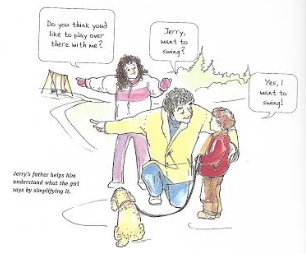
Book Review: More Than Words
More Than Words: Helping Parents Promote Communication and Social Skills in Children with Autism Spectrum Disorder
by Fern Sussman
Published by The Hanen Centre, 1999
But don’t just take my word for it. Here’s some things parents like about this book:
- In each chapter they divide the information according to “level,” from “own agenda” to “partner stage” with examples for each stage. That way you can read the sections that are relevant for you at that moment, so you don’t get bombarded by too much info at once.
- It’s easy to read, good visuals, great examples, a lot of great info.
- Love the visuals, they help to anchor the ideas..
- It’s extremely practical and hands on. You assess your child (maybe with the help of a therapist), and then you have lists and examples of what you can do to move your child along in a way that’s fun for both of you.
So what’s it about? In the introduction, the author explains,
- pays attention to you
- finds enjoyment in two-way communication
- copies the things you do and say
- understands what others say
- interacts with other people
- has fun!
- practices what she learns often
- has structure, repetition and predictability in his or her life (page vi).”
This book does a really good job of explaining how to get your child to that place.
Chapter 1-2: Understanding Your Child and Setting Goals
The first chapter is about observing and understanding your child, and where they are at right now. Likes and dislikes lead to an understanding of how a child senses the world, and gives you clues about where to start in helping your child communicate. The
 chapter also helps you assess how your child already communicates and introduces the stages referred to throughout the book. For example, an “Own Agenda” communicator does not send any messages directly to you, while a “Partner stage” child is able to enjoy short conversations.
chapter also helps you assess how your child already communicates and introduces the stages referred to throughout the book. For example, an “Own Agenda” communicator does not send any messages directly to you, while a “Partner stage” child is able to enjoy short conversations.
Chapter 2 is about goal setting and basic strategies for moving a child through their stage and onto the next one, with plenty of examples. Many of the strategies involve exploring surprises or difficulties – for example, pouring only a small amount of juice into a cup and waiting for your child to indicate that isn’t enough. Every single playful interaction involves a partner to communicate with.
Chapter 3-5: Follow Your Child’s Lead, Take Turns Together, and Play People Games
 These chapters have a lot of common with the DIR/Floortime strategies for the first few levels of development. How do you draw your child into an interaction with you, and keep it going? We start with understanding what our child is interested in, join in, and then build on their ideas to stretch their thinking and conversational stamina. This book offers useful memory aids to help you remember what to do in the moment: OWL for “observe, wait, listen” as you figure out how to join your child; and four I’s to remind you what to do as you join in: “include your child’s interests, interpret as you assume everything your child does sends a message, and respond accordingly, imitate actions and sounds, and intrude – insist on joining in, even if you aren’t welcome at first.”
These chapters have a lot of common with the DIR/Floortime strategies for the first few levels of development. How do you draw your child into an interaction with you, and keep it going? We start with understanding what our child is interested in, join in, and then build on their ideas to stretch their thinking and conversational stamina. This book offers useful memory aids to help you remember what to do in the moment: OWL for “observe, wait, listen” as you figure out how to join your child; and four I’s to remind you what to do as you join in: “include your child’s interests, interpret as you assume everything your child does sends a message, and respond accordingly, imitate actions and sounds, and intrude – insist on joining in, even if you aren’t welcome at first.”Chapters 6-7: Help Your Child Understand What You Say and Use Visual Helpers
 This section is all about what we call “receptive communication” – helping your child expand what he or she can understand. Again, general strategies and goals for each stage are listed, along with many, many illustrated examples. A few pitfalls are listed too, like assuming our child understands when they really don’t.
This section is all about what we call “receptive communication” – helping your child expand what he or she can understand. Again, general strategies and goals for each stage are listed, along with many, many illustrated examples. A few pitfalls are listed too, like assuming our child understands when they really don’t.Chapters 8-12: Building Communication in All Kinds of Settings

Pingback: Five Great Floortime Books | Affect Autism